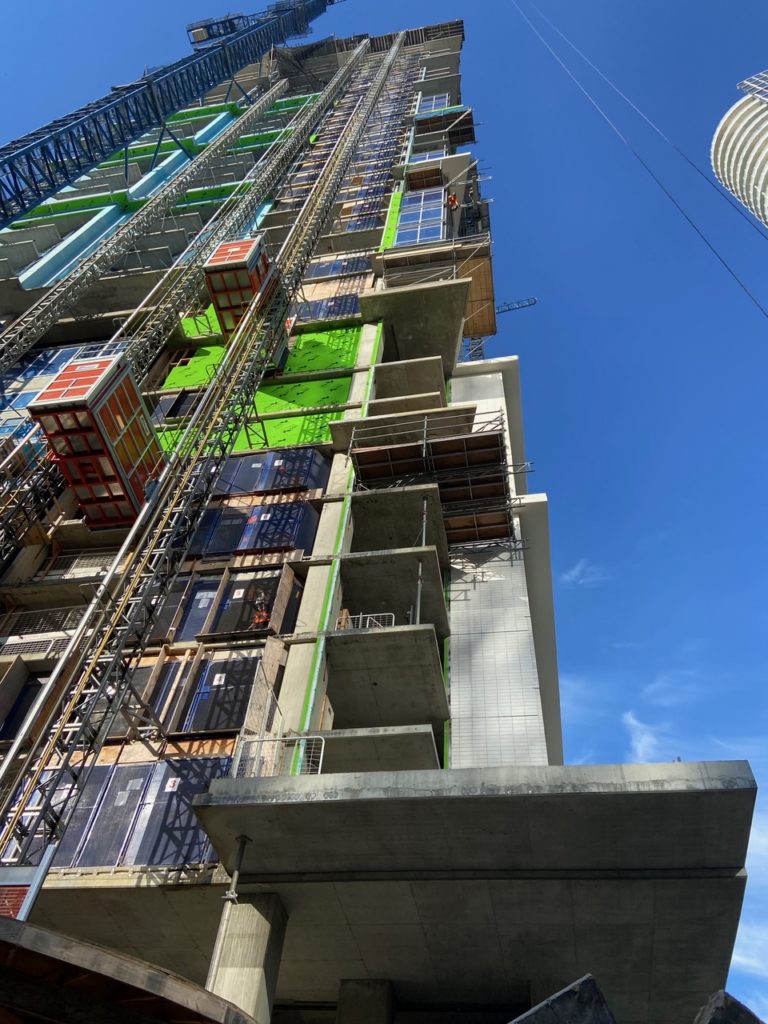Building Atelier: Staying Safe 41 Stories Above Dallas
Staying Safe 41 Stories Above Dallas
While safety is a priority on every job site, the 41-story Atelier luxury high-rise residential tower in Dallas provides some particularly lofty challenges.
Before crews ever set foot on the site, procedures and training were developed, so each individual understood the inherent safety risks of working at such extreme heights. It was crucial every team member was given the tools and knowledge to remain safe while working on the towering project.

The mixed‐use development is the tallest residential rental tower in the Dallas area with 364 residences offering sweeping views of downtown Dallas. KHS&S’ work scope included the exterior EIFS plastering.
Exterior mast climbers, mounted to the building, are essential to reach heights up to 360 feet. The motorized platforms are seven feet wide and 30 feet long, accommodating up to six people working side-by-side.
Operated by a control motor, the platform deck moves up and down along tracks covering 13-story sections. The motor operators were trained by the mast climber manufacturer on operations and safety of the equipment. Up to 17 mast climbers could be in operation during a single day.
Each crew member ties off using a harness and Self Retracting Lifeline (SRL) clasped to a cable running horizontally across the platform deck.
Teams move up the exterior wall completing one floor at a time. Materials are staged every three to five floors so the platform could be restocked. Base coat, mesh, foam and bucket goods are passed out from balconies to the platform – with interior restocking crews also harnessed for safety. Below the climbers, red tape zones prevented other trades from working near the KHS&S platforms.
Mitigating Risk with Comprehensive Safety Planning
The all-inclusive safety plan developed by KHS&S risk management personnel, in conjunction with the construction team, is continually reinforced. The project supervisor and plaster foreman conduct daily safety huddles with up to 30 crew members re-emphasizing the importance of being tied off, tethering tools and red taping work areas. Specific scenarios for the day are also addressed such as weather or other delays. Safety glasses, gloves and hard hats are mandatory.
Leading by example, a 2-hour weekly job site walk is conducted with all trades by the KHS&S OSHA-certified safety director to keep safety at the forefront. While KHS&S holds the contract for the mast climbers, other trades use the equipment for framing and sheetrock. For KHS&S to complete the EIFS work, the teams are dependent on the “trade in front” to complete its piece of the project. Educated on how to recognize, avoid and prevent unsafe conditions, KHS&S inspects the platforms daily to ensure the mast climbers are not damaged or compromised and meet KHS&S’ stringent safety standards.
A comprehensive safety plan takes weather conditions into consideration to ensure the well-being of crews. With temperatures reaching a scorching 100 degrees on many days, water stations are placed throughout the project for ongoing hydration. Work is stopped during rain and if winds exceeded 30 mph.These and other construction safety measures are part of the planning, monitoring and controlling of risk on every job site. KHS&S has distinguished itself as a leader in job safety, even when the risks are elevated, so that each person is trained to make better, smarter and safer decisions.
For related project details, visit https://www.khss.com/projects/atelier/.

